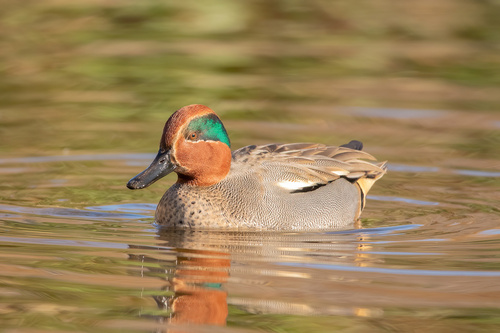
Green-winged Teal
The Green-winged Teal (Anas crecca) is a small dabbling duck found across North America and Eurasia. It is known for its vibrant green speculum, a patch of iridescent feathers on the wing, visible in flight. This species plays an important role in wetland ecosystems as both a seed disperser and a food source for larger predators. While not holding major cultural significance in most areas, it is a popular game bird in some regions, contributing to local economies through hunting and wildlife tourism.
34-38 cm
Length
53-59 cm
Wingspan
Least Concern
Conservation Status
Distribution
Breeds across northern North America (Alaska, Canada) and Eurasia (from Iceland across Siberia to Japan). Winters in southern North America, Central America, northern Africa, and southern Asia. Migratory routes are extensive, often following coastlines and major river systems. Altitudinal range varies from sea level to over 4000 meters in some parts of Asia.
Lifespan
Average lifespan in the wild is 2-3 years, but some individuals have been recorded living over 15 years.
Green-winged Teal's Habitat
Habitat Types
Shallow freshwater wetlands, Marshes, Ponds, Lakes with emergent vegetation, Estuaries, Flooded fields
Climate Zones
Boreal, Temperate, Subtropical (during winter)
Adaptations
Green-winged Teal are well-adapted to shallow water feeding, with a relatively small body size and a bill designed for straining small food items from the water and mud.
Variations
Two subspecies are generally recognized: *Anas crecca crecca* (Eurasian Teal) and *Anas crecca carolinensis* (North American Green-winged Teal). The North American subspecies is slightly larger and has a more prominent vertical white bar on the side of the breast, compared to the horizontal white stripe of the Eurasian Teal.
Appearance
Breeding Plumage
Males in breeding plumage have a chestnut-colored head with a broad green eye patch, a gray body, and a distinctive green speculum bordered by white. Non-breeding males (eclipse plumage) resemble females. Females are mottled brown year-round.
Seasonal Feather Changes
Males undergo a complete molt after breeding, adopting the eclipse plumage. They regain breeding plumage in the fall.
Sex Based Plumage Differences
Significant sexual dimorphism in breeding plumage, with males being much more brightly colored.
Notable Features
Iridescent green speculum, Small size compared to other dabbling ducks, Male's distinctive green eye patch (breeding plumage)
Diet and Feeding
Primary Foods
Seeds, Aquatic invertebrates, Insects, Mollusks, Crustaceans, Plant material (e.g., pondweeds, sedges)
Foraging Behavior
Primarily feeds by dabbling, tipping headfirst into shallow water to reach submerged vegetation and invertebrates. Also grazes on land and occasionally dives.
Specializations
Their bill has fine lamellae (comb-like structures) that help filter small food items from the water.
Seasonal Diet Variations
Diet varies seasonally depending on food availability. Seeds are more important in winter, while invertebrates are crucial during breeding season for egg production and chick growth.
Behavior
Social Structure
Highly gregarious outside of the breeding season, forming large flocks. During breeding, they are territorial, with pairs defending nesting areas.
Communication
Whistles (males), Quacks (females), Visual displays (e.g., head-bobbing, wing-flapping)
Migration
Long-distance migrant. Birds breeding in northern regions travel thousands of kilometers to reach wintering grounds. Migration occurs in flocks, often at night.
Territorial or Group Behaviors
Males defend territories around the nest site during the breeding season. Outside of breeding, they are highly social and form large flocks for foraging and roosting.
Conservation
Threats
Habitat loss and degradation (wetland drainage), Hunting pressure, Pollution (pesticides, heavy metals), Climate change (altering wetland habitats)
Protection Programs
Migratory Bird Treaty Act (US and Canada), Agreement on the Conservation of African-Eurasian Migratory Waterbirds (AEWA), Wetland conservation initiatives (e.g., Ramsar Convention)
Local National Laws
Protected under various national and international laws regulating hunting and habitat protection.
Population Trend
Stable
Population Estimates
The global population is estimated to be in the millions, with significant regional variations.
Interesting Facts
They are one of the smallest dabbling ducks in North America.
Their small size allows them to exploit shallow water habitats that are inaccessible to larger ducks.
The name "teal" is thought to come from the Middle Dutch "telen," meaning "to breed" or "to produce."
This may refer to their relatively high reproductive rate.
Green-winged Teal are known for their rapid, agile flight.
They can quickly twist and turn, making them a challenging target for hunters.
Faqs about Green-winged Teal
What is the difference between the Eurasian Teal and the North American Green-winged Teal?
The North American Green-winged Teal has a vertical white bar on the side of the breast, while the Eurasian Teal has a horizontal white stripe. The North American subspecies is also slightly larger.
Are Green-winged Teal endangered?
No, they are classified as Least Concern by the IUCN. Their populations are relatively stable, although they face threats from habitat loss and hunting.
What do Green-winged Teal chicks eat?
Green-winged Teal chicks primarily eat aquatic invertebrates, such as insects and crustaceans, which are rich in protein needed for growth.
How can I identify a Green-winged Teal?
Look for a small dabbling duck. Males in breeding plumage have a chestnut head with a green eye patch. Both sexes have a bright green speculum (wing patch) visible in flight.
Copyright @ Nature Style Limited. All Rights Reserved.
 English
English